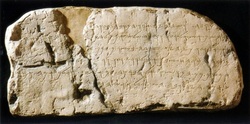 The essential recognition of the significance and truth of the Bible has been obliged by the archaeological discoveries of the past several decades. Our knowledge of the civilizations and history which flourished in the Fertile Crescent of old is better known today than any other period of human history. It has now become possible to examine more closely both culture and language. This possibility is brought to us by the findings of archaeologists. An example such a finding that opens are eyes to the historicity of the Biblical text is the Siloam Tunnel and Inscription. 2 Chronicles 32:2-4 says, “when Hezekiah saw that Sennacherib had come and intended to fight against Jerusalem, he planned with his officers and his mighty men to stop the water of the springs that were outside the city; and they helped him. A great many people were gathered, and they stopped all the springs andthe brook that flowed through the land, saying, ‘Why should the kings of Assyria come and find much water?’” These events occurred in approximately 701 BCE. The King Assyrian king (Sennacherib) laid siege on Hezekiah and Jerusalem. Hezekiah wanted to get the water from the Gihon Spring to his troops and all of Jerusalem without the water getting to the Assyrians. 2 Chronicles 32:30 depicts Hezekiah's solution: "It was Hezekiah who stopped up the spring of water of Upper Gihon, leading it downward west of the City of David.” Hezekiah commissioned his engineers to secure his water source by building a tunnel to divert the water from the Gihon spring over to the southwestern part of the city. The water from the Gihon was diverted into the Gai wadi by means of a tunnel that was 1,750 feet long. The water, then, would be protected from the enemy and accessible from within the city. 2 Kings 20:20 states that Hezekiah “Made the Pool and the conduit and brought water into the city” this verse refers to the tunnel which joins the ‘Spring of Gihon’, through the rock to the reservoir entitled the Pool of Siloam. This ancient tunnel was found in 1838 when it was explored by the American explorer, Edward Robinson, and his missionary acquaintance Eli Smith. The two measured the twists and turns of the tunnel and found it was 1750 ft in length. The straight line expanse from the Spring of Gihon to the Pool of Siloam is only 762 ft, less than half the length of the entire tunnel. In 1880 the inscription in the tunnel was noticed by a boy who told his school teacher Herr Conrad Schick about it. Herr Conrad Schick made the information available to scholars when he discovered it was ancient Hebrew script. The inscription was deciphered by A. H. Sayce, with the help of others. It consists of six lines of Old Hebrew with remarkably distinct lettering, the words being separated from each other by points. The script is comparable to that found in the Moabite and a variety of Phoenician inscriptions. The first half of the inscription is missing, but what remains reads as follows: "[... when] (the tunnel) was driven through: while [ . . . ] (were) still [ . . . ] axe(s), each man toward his fellow, and while there were still three cubits to be cut through, [there was heard] the voice of a man calling to his fellow, for there was an overlap in the rock on the right [and on the left]. And when the tunnel was driven through, the quarrymen hewed (the rock), each man toward his fellow, axe against axe; and the water flowed from the spring toward the reservoir for 1,200 cubits, and the height of the rock above the head(s) of the quarrymen was 100 cubits" The major portion of the inscription describes the moments when the tunnel was being completed. The inscription was cut into the wall inside the entrance. The inscription records how two groups of workers started from opposite ends, digging through the solid rock underground and meeting in the middle. The inscription says that 1200 cubits is approximately 1760 feet which confirms the Biblical measurement for a cubit to equal 18 inches as Josephus cites in the construction of Herod's Temple.
In discussing the building achievements of King Hezekiah, the Bible mentions a tunnel that he had dug under the City of David in Jerusalem to supply water to the upper part of the city. Even though the Siloam Inscription does not refer to King Hezekiah, the tunnel was almost without doubt constructed during his period of influence. The eighth-century BCE dating of the inscription is established by the style of the letters (paleography) and the unique rudiments of grammar and spelling. Furthermore, the inscription counters the arguments of those who argue that the Bible’s account of a Monarchic Period is insignificant. The discovery of the Siloam tunnel confirms what the Bible had already said about King Hezekiah. The Siloam Inscription that was found in the tunnel is arguably the most precious of all ancient Hebrew inscriptions. The inscription currently resides in the Museum of the Ancient Orient in Istanbul Turkey. Works Cited Hirsch, Emil G. and Phillipe Berger. JewishEncyclopedia.com. 2002. 24 September 2011 <http://www.jewishencyclopedia.com/view_friendly.jsp?artid=713&letter=S>. Orlinsky, Harry M. Understanding the Bible Through History and Arcaelogy. New York: Ktav Publishing House, 1972. Pritchard, James B. Ancient Near Eastern Texts. Princeton: Princeton University Press, 1955. Walvoord, John F. and Roy B. Zuck. The Bible Knowlege Commentary. Colorado Springs: Cook, 1983. Wisemen, D. J. Peoples of Old Testament Times. Oxford: Clarendon Press, 1973. Posted by Caleb
0 Comments
Leave a Reply. |
AuthorsCaleb Phelps Archives
July 2021
|
 RSS Feed
RSS Feed